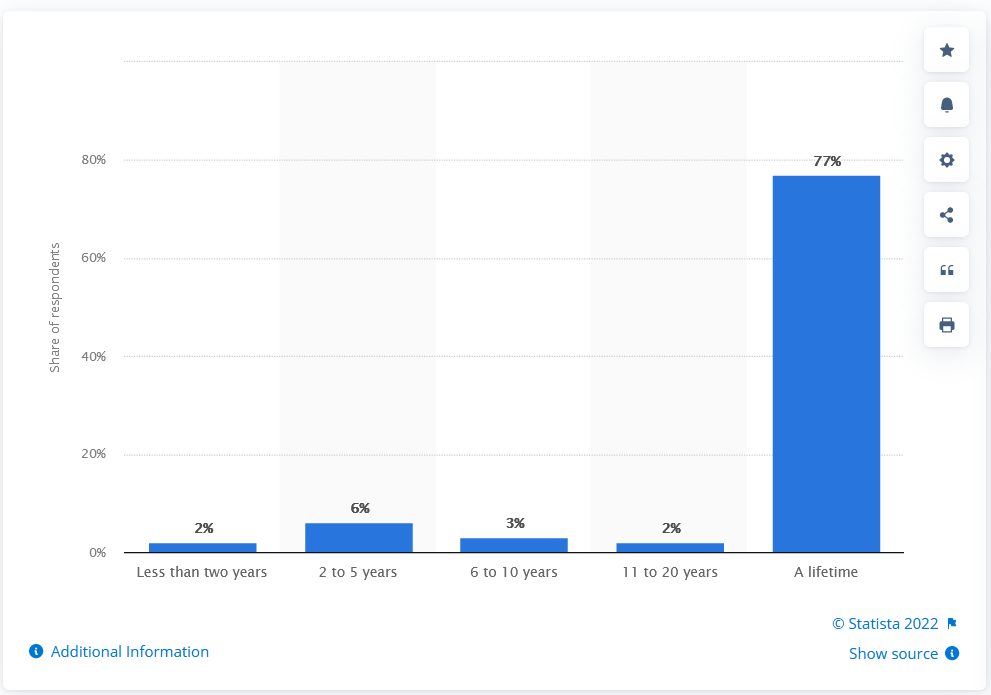
These love statistics prove that falling in love is a beautiful thing.
Love has no preference for:
- gender
- age
- race
- or anything else
Love is 1832 times more powerful than hate.
It will locate you anywhere on the planet, and it will show you the world through fresh eyes.
We require love more than ever before, and these numbers might provide both happiness and comfort.
Table of Contents
Key Love Statistics:
- According to statistics, 88% of Americans marry for love, making it the most popular reason to wed.
- According to a recent survey, 61% of men and women want to marry.
- Most teenagers are in a romantic relationship, with about 19% being in one.
- Laughter has been linked to the pleasurable components of a relationship by studies.
- Men are 5% more confident that they are in love (and consider leaving their partners less).
- Women fall in love at a slower rate.
- Love might help to alleviate pain.
- According to the facts, being in a relationship has a favourable impact on your personality.
- Long-distance relationships have a greater sense of satisfaction and trust.
- When it comes to committing your first love, statistics show that 97 % of people who do so believe they will be together till death.
Interesting Love Facts That Will Give You Butterflies
Let’s start this essay on a good note, as last year brought a lot of stress and bad news into our lives.
Here are some figures and facts about love to warm your heart.
- According to various psychological studies about love, hugging your partner can relieve stress immediately.
Ventral stroking increases oxytocin levels (the cuddle hormone) and lowers blood pressure in animal studies. Human research has revealed comparable findings. For example, after hugging their partners, 59% of women without going through menopause had more significant amounts of oxytocin and reduced blood pressure.
- Being in love can relieve pain.
Another study revealed that experiencing passionate love might help with pain management. The effects of being in love on pain are comparable to those of painkillers. The findings have been characterized as quite strong. Love facts equate the impacts to those of cocaine.
- According to the findings of several studies, being in a relationship has a beneficial impact on your personality.
It has been observed that being in a happy relationship has some significant personality changes. It was discovered, for example, that neuroticism decreases in both partners throughout a happy relationship.
- People who live in different countries are more satisfied and trustful in their relationships.
Even though most individuals think long-distance relationships are doomed from the start, a study has revealed that they have more trust and enjoyment than geographically close ones.
- According to facts, laughter is linked with the good parts of love that couples enjoy.
In research in which couples were filmed while discussing how they met and the qualities of their relationship, it was determined that they laugh together every time they recall something pleasant.
Shared mirth was linked to good relationship quality, social support, and intimacy.
- Women experience a slower falling in love.
Even though most respondents believed women were more likely to fall in love and say “I love you” first in a relationship, men’s love facts reveal that they are more likely to fall in love faster.
- Scientifically verifiable facts about love indicate that love has several phases.
Dopamine levels go up while serotonin levels decrease at first when someone is in love. This creates gooey, stupid, and passionate infatuation like the love of ecstasy. After a year, though, serotonin levels begin to return to normal, turning this into a more calm and wiser type of love.
This is because oxytocin levels rise — the hormone aids in developing marital ties. It boosts the immune system and helps happy couples live longer by reducing mental and physical health issues.
- Statistics regarding falling in love reveal that the brain is stimulated differently by love and desire.
Love and desire are two different feelings that can be mistaken for one another. They appear as distinct brain patterns, with some of the same areas of the brain affected, including reward expectation, social cognition, and somatosensory integration.
It’s one of the (less?) intriguing facts about love that states that it grows out of a desire. It simply expands on the pleasure and sensorimotor experiences we associate with desire. Love also includes habit development and feature detection regions to the existing ones influenced by desire.
American Love Statistics and Facts

As you may expect, it’s the same as anywhere else. Or is it? Let’s look at how Americans live and enjoy their lives.
- The purpose of marriage, according to statistics, is to get married for love, with 88% of Americans doing so.
The second most popular purpose for getting married is to make a lifelong commitment, with 81% of Americans pointing to this as a factor. Companionship ranks third with 76%.
Only 23% of respondents said they would get married due to legal rights and advantages, making these marriage statistics indicate the romantic US.
- Over the age of 50, 4 persons cohabit with their partner without being married.
Although it is a minor proportion, it has risen by 75% since 2007. Americans aged between 25 and 34 are the most common group to cohabit, accounting for around 14% of all adults in this age group.
According to fascinating information about love, the proportion of young people aged 18 to 24 and adults aged 35 to 49 who cohabit is about 9% and 8%, respectively.
- According to statistics, 54% of women are likely to decline being remarried.
In addition, 15% responded yes, whereas 27% were unsure. Only 30% of males answered no to the same question. When it comes to love and relationships, facts reveal that 36% stated they were unsure, whereas almost twice as many women, 29%, said yes.
- According to several statistics, Americans’ attitudes towards same-sex marriage have improved.
Even among doubting groups like baby boomers, the backing for same-sex marriage has grown in the United States over the last ten years. In 2007, 37% of people supported same-sex marriage, but by 2017, this number had risen to 62%, with statistics on love marking a tremendous increase.
- Interracial marriage and same-sex marriage are considered beneficial to society by roughly half of the millennials and Gen Z-ers.
According to statistics, some good trends have emerged in the history of love and relationships. Younger generations promote difference, with 48% of Generation Z-ers and 47% of millennials believing same-sex marriage is a positive social benefit.
Furthermore, half of both generations (51 % of millennials and 43 % of Gen-Xers) believe that interracial marriage is wrong. In comparison, just 27% and 30% of the baby boomers feel same-sex and interracial marriages are acceptable.
Love Statistics and Facts — Love and Marriage

After you say ‘yes,’ there is no difference between married couples who love each other and those that don’t. While this may be the case, marriage statistics reveal that marital perceptions and relationships are significantly different from decades ago.
- Married people under 50 are 12% less likely to have vascular disease.
These rather odd facts about love show a declining trend with age (but a favourable one nevertheless). Married people are 7% less likely to get a vascular disease than those aged 50-51 to 60. This proportion falls to 4% for married and older than 61.
- Almost 61% of men and women want to get married.
Most people who have never married before seeing it as their life goal. According to statistics on love and marriage, 27% of individuals are unsure if they want to marry, while only 12% said they did not want to marry.
According to the marriage statistics, those married previously are less enthusiastic about remarrying, with only 29% saying they would.
- About 19% of teenagers are in a romantic relationship.
Around 14% of teenagers are in a romantic relationship, which they consider serious. Another 5% of youngsters are in relationships that they view as romantic.
They do, however, consider these connections to be unimportant. Furthermore, around 16% of teens are not dating (but have dated before).
- 64 % of teenagers claimed they had never been in a romantic relationship, according to the poll.
The remaining 35% (1% refused to disclose their romantic relationship status) said they are presently involved with a partner, have had a companion in the past, or have hooked up with someone.
- According to studies, the majority of teenagers are not sexually active.
A recent study conducted by the National Teen Dating Abuse Helpline found that 30% of teen daters have had sex. This is a significant finding, as it suggests that many young people are engaging in sexual activity, even though they may not be ready or prepared for it. The study also found that most of those who did have sex said that they regretted it afterwards. This is an important reminder for teens that having sex is a big decision and one that should not be taken lightly. It is also important to remember that consent must be given by both parties before any sexual activity takes place. If you are a teen thinking about having sex, make sure you are ready physically, emotionally, and mentally. You should also make sure you are doing it for the right reasons and not because you feel pressured or pressured by someone else. Lastly, always use protection to reduce your risk of contracting a sexually transmitted infection or becoming pregnant.
- When it comes to marrying your first love, statistics indicate that about 97% of those who do so believe they will be together until death.
According to these statistics, over 90% of first-love marriages genuinely believe in “until death do us part.” They are more likely than others to think so (88%). Furthermore, compared to those not in a first-love marriage, only 19% of first-love marriage partners considered leaving their partner, whereas 34% of persons who were not in a relationship with their first love considered doing so.
- Men are more confident that they are in love, with a 5% greater chance of wanting to leave their partners.
According to recent survey data, about 62% of males are confident that they are in love with their spouse, whereas only 57% of females feel the same. According to statistics, 38% of women have considered leaving their partners, while 29% of males have considered doing the same.
Conclusion
These love statistics may be surprising to some but wholly expected to others.
How you view love may affect your perspective on these statistics, but we agree it’s nice to see the world happy.
Marriage and romantic relationships are some of the most special bonds we can ever hope to form, and we should always cherish them.
FAQ on Love Statistics and Facts
What % age of relationships are happy?
According to a poll from last year, 83% of married couples in the United States said they were happy in their relationship. In comparison, just 64% of Americans claimed to be satisfied with their relationships in 2018. This is an incredible rise for only one year.
Sources:
- Modern Gentlemen
- Statista
- American College of Cardiology
- Pub Med
- The Harvard Gazette
- The Journal of Social Psychology
- Cision
- Pew Research Center
- Stanford Medicine
- YouGov
- The Journal of Sexual Medicine
- Wiley Online Library
Related:
Love At First Sight Statistics

Petri Maatta is a photographer, filmmaker, and webdesigner who has been working for over 20 years in the creative industry. Fascinated by manifesting for business reasons, Petri was determined to find out what it took to create success. He started his career with seven years of business failures before he found success by learning about manifesting from a mentor with a Fortune 500 company. Today Petri shares his knowledge through DreamMaker courses designed to help people change their businesses and lives while living on their terms.
STAY IN THE LOOP
Subscribe to our free newsletter.
Stay up to date! Get all the latest & greatest posts delivered straight to your inbox


